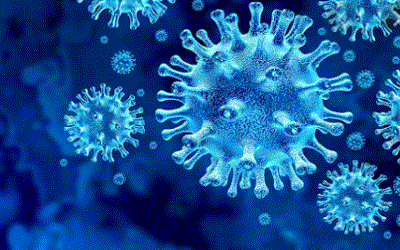Research | Infectious Disease | Global

Before March, most of the SARS-CoV-2 genomes that researchers worldwide isolated and sequenced encoded an aspartic acid (D) at residue 614 of the viral spike protein. By April, the majority of viral sequences harbored a single mutation in the genome converting the D to a glycine (G). Presently, the 614D variant has been all but replaced by the 614G variant globally. These findings, described in a study published in Cell in August, and corroborating evidence from other groups have led scientists around the world to investigate whether the rapid shift in representation of circulating viral strains is based on random introduction by a group of mobile founders or if it indicates that 614G provides some sort of selective advantage to the virus—making it more infective, for instance.
An answer to this question would have big importance to addressing the pandemic, according to Jessica Plante, a virologist at the World Reference Center for Emerging Viruses and Arboviruses at the University of Texas Medical Branch, because “a random event is unlikely to have massive epidemiological consequences.” On the other hand, she says, “if the virus is truly more infectious, or if the virus is causing more severe disease, that’s something that we need to be able to verify very quickly, so that the public health side can realize that a more contagious or a more severe form of the virus is now spreading.” Several studies published this fall point to the latter, that 614G transmits more readily than 614D.
In a paper published in Cell November 18, researchers evaluated more than 25,000 whole genome SARS-CoV-2 sequences collected in the United Kingdom between January and June. As in other places, 614G became the dominant variant in late March in the UK, after multiple independent introductions, mostly from people who had traveled internationally. The authors also confirmed that 614G is not associated with infection severity and observed that younger patients were more likely to have 614G and have higher viral loads. Their results support the idea that 614G is under positive selection and likely affects virus transmissibility.
“Even with that massive data set, we were almost pushing the limit of the ability to identify that this effect was there,” coauthor Thomas Connor, a genetic epidemiologist at Cardiff University in Wales, tells The Scientist. Detecting such a subtle change in infectivity would be much more difficult with a smaller sample size.
“What they suggest is that the patterns that we see are consistent with a selective advantage, and that this gene mutation arose and has now dominated because it is likely an adaptation [to] humans,” says Nathan Grubaugh, an epidemiologist at the Yale School of Public Health who did not participate in the work. “We’ve seen in the past where you have something from an animal population that spills over into humans, it’s going to slightly adapt to be better in the system.”
That apparent heightened contagiousness of 614G could be due to the production of more virus during infection. Hultquist’s group published a paper November 11 showing that patients infected with the 614G variant had higher viral loads in their upper airways than did patients with 614D.
The findings hold up in animal models, too. Plante and her colleagues showed in a study in October that hamsters infected with the 614G variant had higher viral loads in the upper respiratory tract, but not in the lungs, than did animals with 614D. They hypothesize that these higher viral loads could lead to increased transmission.
“It’s speculated that the more virus you have, the more contagious you might be to somebody else,” says Grubaugh. “And in principle that makes sense, but in reality that’s also a hard thing to prove or disprove.”
The next question is to determine in a transmission model whether the 614G variant really is more infectious, Hultquist says. “Multiple independent groups have now collected data that is consistent with the 614G variant of the virus being more transmissible, but it still hasn’t been proven that the virus is more transmissible.”
Martin Beer, a virologist at the Friedrich Loeffler Institute in Germany, and colleagues released a preprint on October 27 that includes a head-to-head comparison of 614G and 614D in ferret and hamster models of viral transmission. “In this competition experiment, with a 50/50 mixture, the 614G out-competed the 614D in most cases,” he says.
Taking all these various lines of evidence from the lab and epidemiological observations of the pandemic together, “there is an indication now . . . that this is most likely not a founder effect. This is probably a real advantage for the virus,” Beer says. But to which extent the 614G variant is more easily transmitted under real-world conditions is a difficult task, he adds. “614G is for sure not less efficient than the 614D. There is a good chance that it is more efficient—for example, in a ‘super spreader’ event.”
Because multiple groups have shown that neither form has “an impact, at least that we know of, on disease severity, knowing what virus you’re infected with won’t impact your treatment regimen or whether or not you will be protected from a vaccine, or whether the drugs will work,” says Grubaugh.
“The things that [people] can do to protect themselves from one variant or another variant are all the same,” agrees Hultquist. “Wear a mask. Be cognizant of your social distancing. Wash your hands regularly, and follow local public health guidelines.”
More details can be found at : https://www.the-scientist.com/news-opinion/sars-cov-2-genetic-variant-may-be-more-transmissible-68201

